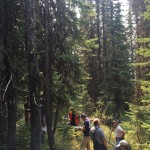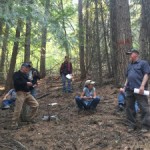Forest Collaboration
Posted: April 5, 2016Source: The Forest Blog
By: Russ Vaagen

The Oxford Dictionary says that collaboration is the action of working with someone to produce or create something. It also says that collaboration can mean traitorous cooperation with an enemy, but for our purposes we’re attempting to operate under the first definition. Simply put, community members, organizations, and other interested parties come together to discuss what is taking place within the forest, specifically the local National Forest. Once a collaborative group is formed, the basic foundation of meetings revolves around land management decisions, which often pertain to local Forest Service lands. This is a good way to coordinate comments from a large segment of the interested and informed public.
So why is collaboration so important? It’s important because the Forest Service needs a way to effectively and systematically communicate with the public and relevant organizations. In the past, the Forest Service would ask the public to comment on a proposed action they wanted to perform. When feedback was collected, conflicting opinions from various groups resulted in ambiguity on what the Forest Service should do. Ultimately, the Forest Service team was tasked with interpreting mixed feedback and making adjustments to proposed projects. In many cases, adjustments were not satisfactory to the groups and individuals commenting on proposals. Unfortunately, this resulted in objections to projects, and in some cases, lawsuits were filed against the Forest Service in attempt to bring projects to a halt. This process was unproductive and frustrating. With collaboration, groups and people from the public with conflicting views are able to meet prior to commenting on Forest Service proposals. This is where they can discuss and settle on what actions they would like to see performed. This allows progress and appeases all parties involved.
In 2003, the Healthy Forest Restoration Act formally paved the way for the use of collaboration. Some groups were already formed, but most groups were still in their infancies. It may have been most important to gain the support of the Forest Service. As a federal organization that had been highly scrutinized, their level of trust with the forest industry, the environmental groups, and every group in between was at an all-time low. These groups needed legitimacy and the Forest Service needed direction. Collaboration became the light at the end of a long tunnel.

Collaborative discussions about an upcomingproject
Collaboration is a long-term commitment that requires trust, dedication and an understanding that there are no quick fixes. After all, these are forests and they require generational thinking and planning. The first step in collaboration is forming the collaborative group, or coalition. Usually in a given National Forest there exists a core group that already works on forest issues. In the case of the Northeast Washington Forestry Coalition, the founding group members were Duane Vaagen, second generation owner and president of Vaagen Brothers Lumber and Tim Coleman, founding member and Executive Director of the Kettle Range Conservation Group. The two individuals were on opposing ends of the Timber Wards in the 80’s and 90’s, but chose to convene to determine if there was a willingness to communicate. In 2002 they formed what has become the strong coalition that exists today. Fast forward to 2016 and this group, which has a functioning board and the support of many local businesses, community leaders and elected officials, has successfully collaborated on nearly 40 projects on the Colville National Forest. This coalition is not alone, and there are groups with similar stories and varying levels of success throughout the inter-mountain west.
These groups meet, develop trusting relationships, and establish ground rules and guidelines in order to help the Forest Service identify and manage landscapes. There are still naysayers. Some even believe that collaboration only means traitorous cooperation with an enemy, but the groups still move forward. These groups and their members are hopeful that collaboration starts to work as a funnel for comments and concerns for the collective interest of the forest. Resolving issues ahead of time and working with the Forest Service professionals helps ensure projects have a high degree of success. Each successful project leads to better outcomes and a smoother decision-making process. History will decide whether collaboration is a great success or not, but after having been involved with Forest Service collaboration for 14 years it is my opinion that we’re on the verge of making lasting changes that future generations will be proud of and grateful for.
